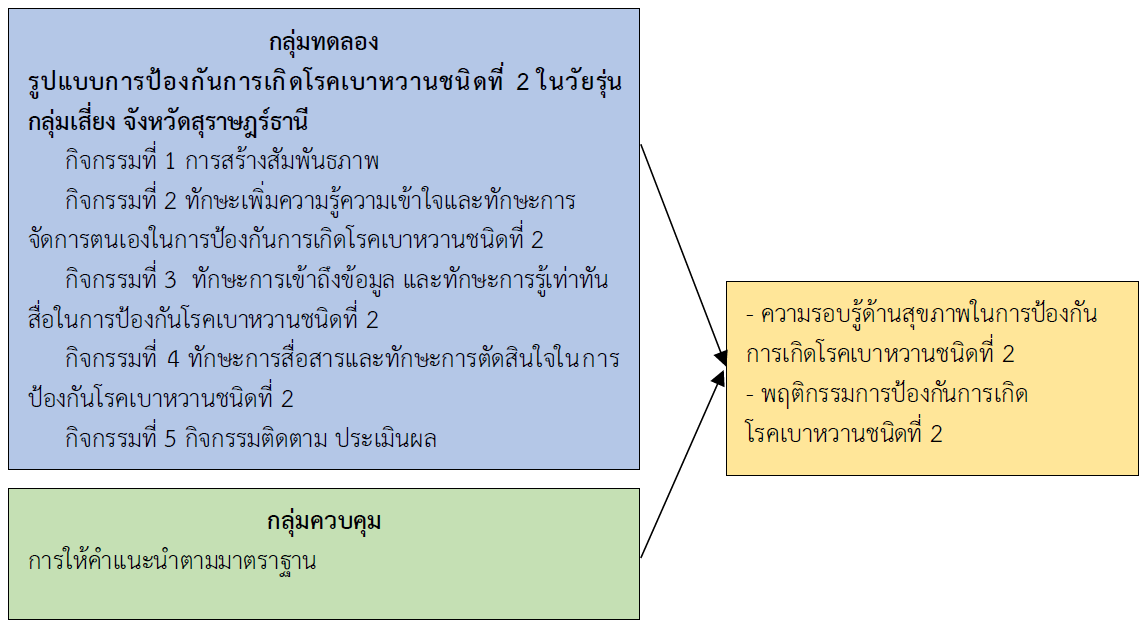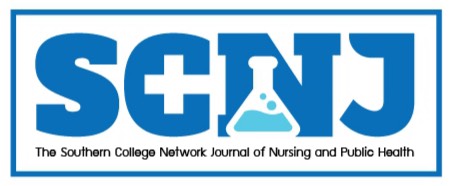The Effects of a Type 2 Diabetes Prevention Model on Health Literacy and Diabetes Prevention Behaviors among Adolescents in High-Risk Groups, Surat Thani Province
Keywords:
Type 2 Diabetes, Health Literacy, Prevention Behaviors of Diabetes, High-risk AdolescentsAbstract
This two-group pretest-posttest quasi-experimental design study aimed to compare the health literacy and diabetes prevention behavior scores among adolescents at high-risk for type 2 diabetes. The participants were 100 high-risk adolescents from schools in Surat Thani Province, equally distributed between experimental group (n = 50) and control group (n = 50). The research instruments included: 1) the newly developed type 2 diabetes prevention model for high- risk adolescents, 2) the "I Can Do" health record manual, 3) a health literacy questionnaire, and 4) a diabetes prevention behavior questionnaire. The content validity was assessed by three experts, yielding item consistency indices ranging from 0.66 to 1.00. Reliability of the health literacy questionnaire and diabetes prevention behavior questionnaire was determined using Cronbach's alpha coefficient, which was found to be at the 0.80 and 0.82 levels, respectively. General data were analyzed using descriptive statistics including frequency, percentage, mean, and standard deviation. The comparison of average health literacy and diabetes prevention behavior scores before and after the implementation of type 2 diabetes prevention model in the experimental group was conducted using a paired t-test. Additionally, differences in average scores for health literacy and diabetes prevention behavior between the experimental group and the control group were analyzed using an independent t-test. The research results showed as follows.
1. After using the type 2 diabetes prevention model among high-risk adolescents, the experimental group had higher scores than before with statistical significance at the .001 level, and this, for both health literacy (t = 11.10, p-value < .001) and diabetes prevention behaviors (t = 6.16, p-value < .001).
2. When comparing the average scores for health literacy and diabetes prevention behaviors after the intervention, the experimental group scored significantly higher (t = 5.56, p-value < .001) than the control group (t = 4.80, p-value < .001).
Therefore, this new type 2 diabetes prevention model has the potential to improve health literacy preventive behaviors among high-risk adolescents, thereby contributing to an enhanced quality of life for this segment of population.
References
Bureelerd, O., Songserm, N., & Charoenbut, P. (2018). Behavior modification model for preventing type 2 diabetes in primary school students, Huachiew Chlermprakiet Science and Technology Journal, 4(2), 20-29. (in Thai)
Calabria, A. (2024). Diabetes Mellitus in Children and Adolescents. Retrieved July 3, 2024 from https://www.msdmanuals.com/professional/pediatrics/endocrine-disorders-in-children/diabetes-mellitus-in-children-and-adolescents.
Choojai, R., Boonsiri, C., & Patcheep, K. (2021). Effects of a health literacy enhancement program for COVID-19 prevention on health literacy and prevention behavior of COVID-19 among village health volunteers in Don Tako sub-district, Mueang district, Ratchaburi province. The Southern College Network Journal of Nursing and Public Health, 8(1), 250-262. (in Thai)
Department of Disease Control. (2023). Annual Report 2023. Bangkok: Aksorn Graphic and Design Publishing. (in Thai)
Faul, F., Erdfelder, E., Lang, A.G., & Buchner, A. (2007). G*Power 3: A flexible statistical power analysis program for the social, behavioral, and biomedical sciences. Behavior Research Methods, 39, 175-191.
Fleary, S. A., Joseph, P., & Pappagianopoulos, J. E. (2018). Adolescent health literacy and health behaviors: A systematic review. Journal of Adolescence, 62, 116–127. doi.org/10.1016/j.adolescence.2017.11.010
Hair, J. F., Black, W. C., Babin, B. J., & Anderson, R. E. (2019). Multivariate Data Analysis. (8th ed.). Pearson: Upper Saddle River.
International Diabetes Federation. (2021). IDF Diabetes Atlas - 10th edition. Retrieved November 10, 2023 from www.diabetesatlas.org. (in Thai)
Jewsuebpong, W., Lekphet, K., Nawamawat, J., & Wanjan, P. (2022). The effect of health literacy on glycemic control among diabetes type II patients. Research and Development Health System Journal, 15(3), 30-43. (in Thai)
Kaewboran, S., Samartkit, N., & Masingboon, K. (2019). Factors predicting diabetes prevention behaviors among adolescents at risk for type II diabetes in Samutprakan. Journal of Nursing and Health Care, 37(2), 218-227. (in Thai)
Marciano, L., Camerini, A. L., & Schulz, P. J. (2019). The role of health literacy in diabetes knowledge, self-care, and glycemic control: A meta-analysis. Journal of General Internal Medicine, 34(6), 1007–1017. doi.org/10.1007/s11606-019-04832-y
Moungkum, S., Srisopa, P., Kunsongkeit, W., Ponpinij P., Wiseso, W., Chantamit-O-Pas, C., & Deerochanawong, C. (2020). Factors influencing microvascular complications among persons with type 2 diabetes. The Journal of Faculty of Nursing Burapha University, 28(2), 74-84. (in Thai)
Nantarakchaikul, P. (2015). Children with diabetes mellitus in Suratthani hospital. Region 11 Medical Journal, 29(3), 353-364. (in Thai)
No-in, K. (2017). Overweight and obesity among Thai school-aged children and adolescents. Journal of The Royal Thai Army Nurses, 18(Supplement), 1-8. (in Thai)
Nutbeam, D. (2000). Health literacy as a public health goal: a challenge for contemporary health education and communication strategies into the 21st century. Health Promotion International, 15(3), 259–267.
Nutbeam, D. (2008). The evolving concept of health literacy. Social Science & Medicine, 67(12), 2072-2078.
Pinhas-Hamiel, O., & Zeitler, P. (2023). Type 2 Diabetes in Children and Adolescents- A Focus on Diagnosis and Treatment. Retrieved February 15, 2024 from https://www.ncbi.nlm.nih.gov /books/NBK597439/
Phormpayak, D., Thongrat, Y., Limkamontip, S., & Chidnayee, S. (2019). Self-Management Experience of Adolescent Patients with Diabetic Mellitus. Songklanagarind Journal of Nursing, 39(4), 63-72. (in Thai)
Rabin, N. (2023). November 14, World Diabetes Day. Faculty of Medicine, Chiang Mai University. Retrieved November 26, 2023 from https://www.cmu.ac.th/th/article/1516e9d1-9cb9-40fa-ba98-9285046ddfe6
Saentecha, P., & Lamluk, P. (2020). The effectiveness of a program for health literacy development in the patients with type 2 diabetes. Thai Journal of Health Education, 43(2), 150-164. (in Thai)
Sila-Ngam, W. (2018). Dangers of smartphone addiction. Journal of Health Sciences and Wellness, 22(43-44), 193-204. (in Thai)
Stufflebeam, D. L., & Shinkfield, A. J. (2007). Evaluation Theory, Models and Applications. San Francisco: Jossey-Bass.
Techakanta, P., Tamdee, D., & Sripetchwandee, N. (2024). The effects of a food literacy program on eating behaviors among adults with uncontrolled hypertension in a local community. The Southern College Network Journal of Nursing and Public Health, 11(3), e268776. (in Thai)
The Royal College of Physicians of Thailand, Diabetes Association of Thailand under The Patronageof Her Royal Highness Princess Maha Chakri Sirindhorn, The Endocrine Society of Thailand, Department of Medical Services, National Health Security Office. (2023). DiaClinical Practice Guideline for Diabetes 2023. Bangkok: Sri Muang Printing. (in Thai)
Wangpitipanit, S., Terathongkum, S., & Pakpayak, M. (2017). Effects of a RANS 30 exercise program on diabetic preventive behavior, body mass index, and capillary blood glucose in persons with pre-diabetes. Ramathibodi Nursing Journal, 23(3), 358-370. (in Thai)
Wijitraphan, T. (2020). Effectiveness of health literacy and health behavior promoting program in risk group of diabetes mellitus at Thung Siao primary care cluster, Sanpatong district, Chiangmai province. Journal of Health Science, 29(4), 618-624. (in Thai)
Xu, H., & Verre, M. C. (2018). Type 2 diabetes mellitus in children. American Family Physician,98(9), 590-594.
Ya-in, B. (2021). The effects of health literacy enhancement program on self-care behaviors of patients with uncontrolled diabetes type II, chumsaeng Hospital in Nakhonsawan Province Sawanpracharak Medical Journal, 18 (1), 35-48. (in Thai)

Downloads
Published
Issue
Section
License
Copyright (c) 2025 The Southern College Network Journal of Nursing and Public Health

This work is licensed under a Creative Commons Attribution-NonCommercial-NoDerivatives 4.0 International License.
1. บทความหรือข้อคิดเห็นใด ๆ ที่ปรากฏในวารสารเครือข่าย วิทยาลัยพยาบาลและการสาธารณสุขภาคใต้ ที่เป็นวรรณกรรมของผู้เขียน บรรณาธิการหรือเครือข่ายวิทยาลัยพยาบาลและวิทยาลัยการสาธารณสุขภาคใต้ ไม่จำเป็นต้องเห็นด้วย
2. บทความที่ได้รับการตีพิมพ์ถือเป็นลิขสิทธิ์ของ วารสารเครือข่ายวิทยาลัยพยาบาลและการสาธารณสุขภาคใต้







